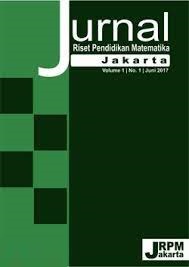ANALISIS KEMAMPUAN LITERASI MATEMATIKA SISWA KELAS X MELALUI KOMIKA PADA MATERI BENTUK ALJABAR DI SMA NEGERI 1 SINTANG
DOI:
https://doi.org/10.21009/jrpmj.v4i2.25084Keywords:
comics; algebraic form; mathematical literacy; teaching materialsAbstract
The purpose of this study was to produce comic-based teaching materials in algebraic forms to improve students' literacy skills. This study aims to: 1) Describe the procedure for developing comic-based teaching materials on algebraic materials to improve students' literacy skills. 2) Improve students' literacy skills after using comic-based teaching materials. 3) Knowing the responses of students and teachers to the use of comic-based teaching materials in algebraic forms to improve students' literacy skills. The research method used is R&D. The research site is at SMAN I Sintang. The assessment of mathematical literacy abilities of students in class X IPS 1 SMAN 1 Sintang is high with an average score of 71.08% at the level of problem solving and mathematical reasoning abilities. Meanwhile, the teacher's response based on the teacher's response questionnaire analysis had an average value of 75% with interpretation criteria, and student responses based on the results of the student response questionnaire analysis had an average value of 79.75% with interpretation criteria.Soit can be concluded that the development of learning media carried out is declared feasible, interesting and effective to use in learning
References
Hasanah, U. (2016). Pengembangan kemampuan fisik motorik melalui permainan tradisional bagi anak usia dini. Jurnal Pendidikan Anak, 5(1).
Hera, R., & Sari, N. (2015). SEMINAR NASIONAL MATEMATIKA DAN PENDIDIKAN MATEMATIKA UNY 2015 713 Literasi Matematika: Apa, Mengapa dan Bagaimana? 713-720
Janah, S. R., Suyitno, H., & Rosyida, I. (2019). Pentingnya Literasi Matematika dan Berpikir Kritis Matematika Dalam Menghadapi Abad Ke-21. In Prisma, Prosiding Seminar Nasional Matematika, 2, 905–910
Karim, A., & Nurrahmah, A. (2018). Analisis Kemampuan Pemahaman Matematis MahasiswaPada Mata Kuliah Teori Bilangan. Jurnal Analisa, 4(1), 179–187.https://doi.org/10.15575/ja.v4i1.2101
Kurniasih, N., Hidayani, F. ., Muchlis, A. ., & Soebagyo, J. (2021). Analisis Kemandirian Belajar Matematika Siswa SMA Kelas XI Selama Pembelajaran Jarak Jauh. International Journal of Progressive Mathematics Education, 1(2), 116–126. https://doi.org/10.22236/ijopme.v1i2.6568
Kosiret, A. ., Indiyah, F. H. ., & Wijayanti, D. A. . (2021). The Use of Generative Learning Model in Improving Students’ Understanding of Mathematical Concepts of Al-Azhar 19 Islamic High School. International Journal of Progressive Mathematics Education, 1(1), 16–26. https://doi.org/10.22236/ijopme.v1i1.6593
Kusmanto, H. (2014). Pengaruh Pemahaman Matematika Terhadap Kemampuan Koneksi Matematika Siswa Kelas VII Semester Genap SMP Negeri 2 Kasokandel Kabupaten Majalengka. Eduma: Mathematics Education Learning and Teaching, 3(2).
Kusumawardani, D. R., Wardono, & Kartono. (2018). Pentingnya Penalaran Matematika dalam Meningkatkan Kemampuan Literasi Matematika. Prisma, 1(1), 588–595
Putra, A. P. (2018). Analisis Kesulitan Belajar Siswa Kelas VII SMP PGRI Arjosan Kabupaten Pacitan dalam Mempelajari Aljabar Tahun Pelajaran 2012. MAJU : Jurnal Ilmiah Pendidikan Matematika, 2(1).
Rakasiwi, N., & Wahyudi & Indarini, E. (2019). Development of comic media using the picture and picture method to improve class IV mathematics literacy skills. AKSIOMA: Journal of Mathematics and Mathematics Education, 10(1), 60-70.
Saida, . A. ., Ikram, M., & Salwah. (2021). Analysis of Students’ Creative Thinking in Solving Cuboid Problems. International Journal of Progressive Mathematics Education, 1(2), 104–116. https://doi.org/10.22236/ijopme.v1i2.7307
Sari, R. H. N. (2015, November). Literasi Matematika: Apa, Mengapa dan Bagaimana. In Seminar Nasional matematika dan pendidikan matematika UNY (Vol. 8). Yogyakarta: Universitas Negeri Yogyakarta.
Sari, Susi Purnama, Anita Trisiana, and Ema Butsi Prihastari. "ANALISIS KEMAMPUAN LITERASI MATEMATIKA PESERTA DIDIK KELAS I MELALUI KOMIK ETNOMATEMATIKA MATERI OPERASI HITUNG BILANGAN CACAH DI SDICT AL ABIDIN SURAKARTA TAHUN PELAJARAN 2020/2021." Pena Kreatif: Jurnal Pendidikan 10.2 (2021): 36-45.
Setiani, Y., & Rafianti, I. (2018). Pengaruh Tingkat Kecerdasan Visual-Spasial terhadap Literasi Kuantitatif Mahasiswa Calon Guru Matematika. Kreano, Jurnal Matematika Kreatif-Inovatif, 9(1), 38-46.
Salasia, S. I. O., Tato, S., Sugiyono, N., Ariyanti, D., & Prabawati, F. (2011). Genotypic characterization of Staphylococcus aureus isolated from bovines, humans, and food in Indonesia. Journal of Veterinary Science, 12(4), 353-361.
Sugiyono. 2008. Statistik Nonparametris untuk Penelitian. Bandung: Alfabeta.
Sulistyorini, E. E., Laili, N. ., & Rahmadiana, S. . (2021). Profil Pemahaman Siswa Pada Materi Peluang Berdasarkan Tingkat Kemampuan Matematis Melalui Pembelajaran Jarak Jauh (PJJ). International Journal of Progressive Mathematics Education, 1(2), 143–160. https://doi.org/10.22236/ijopme.v1i2.6569
Syazali, M. (2015). Pengaruh Model Pembelajaran Creative Problem Solving Berbantuan Media Maple 11 Terhadap Kemampuan Pemecahan Masalah Matematis. Al-Jabar: Jurnal Pendidikan Matematika, 6(1), 91-98.
Wahyuni, I., & Kharimah, N. I. (2017). Analisis kemampuan pemahaman dan penalaran matematis mahasiswa tingkat iv materi sistem bilangan kompleks pada mata kuliah analisis kompleks. JNPM (Jurnal Nasional Pendidikan Matematika), 1(2), 228-240.




